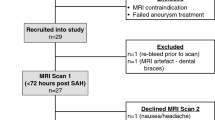Abstract
Many survivors of aneurysmal subarachnoid haemorrhage (aSAH) have persistent cognitive deficits. Underlying causes of these deficits have not been elucidated. We aimed to investigate if cerebral perfusion in the acute phase after aSAH measured with CT perfusion (CTP) is associated with cognitive outcome 3 months after aSAH. We included 71 patients admitted to the University Medical Center Utrecht who had CTP performed within 24 h after ictus and neuropsychological examination after 3 months. Perfusion values were measured in predefined regions of interest for cerebral blood flow (CBF), cerebral blood volume (CBV), mean transit time (MTT), and time to peak (TTP). The relationship with global cognitive functioning, as measured with a mean z score of all cognitive tests, was examined by linear regression analyses. Adjustments were made for age, education, method of aneurysm treatment, and presence of non-acute medical complications. TTP was associated with cognitive functioning in the univariable analysis (B = −0.042, 95 % CI −0.076 to −0.008), but not after adjustment for age (B = −0.030, 95 % CI −0.065 to 0.004). For CBF, CBV and MTT no relationship with cognitive functioning was observed. Cerebral perfusion measured with CTP within 24 h after onset of aSAH is not associated with cognitive outcome after 3 months. The lack of an association might be explained by the delay between onset of aSAH and CTP. However, CTP assessment within the first minutes after aSAH is impossible in large series of patients.

Similar content being viewed by others
References
Al-Khindi T, Macdonald RL, Schweizer TA (2010) Cognitive and functional outcome after aneurysmal subarachnoid haemorrhage. Stroke 41:e519–e536
Passier PE, Visser-Meily JM, van Zandvoort MJ et al (2012) Predictors of long-term health-related quality of life in patients with aneurysmal subarachnoid haemorrhage. NeuroRehabilitation 30:137–145
Hutter BO, Kreitschmann-Andermahr I, Mayfrank L et al (1999) Functional outcome after aneurysmal subarachnoid haemorrhage. Acta Neurochir Suppl 72:157–174
Orbo M, Waterloo K, Egge A et al (2008) Predictors for cognitive impairment one year after surgery for aneurysmal subarachnoid haemorrhage. J Neurol 255:1770–1776
Haug T, Sorteberg A, Sorteberg W et al (2007) Cognitive outcome after aneurysmal subarachnoid haemorrhage: time course of recovery and relationship to clinical, radiological, and management parameters. Neurosurgery 60:649–656
Kreiter KT, Copeland D, Bernardini GL et al (2002) Predictors of cognitive dysfunction after subarachnoid haemorrhage. Stroke 33:200–208
Wu O, Ostergaard L, Weisskoff RM et al (2003) Tracer arrival timing-insensitive technique for estimating flow in MR perfusion-weighted imaging using singular value decomposition with a block-circulant deconvolution matrix. Magn Reson Med 50:164–174
Verhage F (1964) Intelligentie en leeftijd: onderzoek bij Nederlanders van twaalf tot zevenenzeventig jaar (Intelligence and Age: a study among Dutch people from age 12 to 77). Van Gorcum, Assen
Vergouwen MD, Vermeulen M, Van Gijn J et al (2010) Definition of delayed cerebral ischemia after aneurysmal subarachnoid haemorrhage as an outcome event in clinical trials and observational studies: proposal of a multidisciplinary research group. Stroke 41:2391–2395
Van Gijn J, Hijdra A, Wijdicks EF et al (1985) Acute hydrocephalus after aneurysmal subarachnoid haemorrhage. J Neurosurg 63:355–362
Mustonen T, Koivisto T, Vanninen R et al (2008) Heterogeneity of cerebral perfusion 1 week after haemorrhage is an independent predictor of clinical outcome in patients with aneurysmal subarachnoid haemorrhage. J Neurol Neurosurg Psychiatry 79:1128–1133
Sehba FA, Hou J, Pluta RM et al (2012) The importance of early brain injury after subarachnoid hemorrhage. Prog Neurobiol 97:14–37
Sehba FA, Mostafa G, Knopman J et al (2004) Acute alterations in microvascular basal lamina after subarachnoid hemorrhage. J Neurosurg 101:633–640
Sehba FA, Mostafa G, Friedrich V Jr et al (2005) Acute microvascular platelet aggregation after subarachnoid hemorrhage. J Neurosurg 102:1094–1100
Bederson JB, Levy AL, Ding WH et al (1998) Acute vasoconstriction after subarachnoid hemorrhage. Neurosurgery 42:352–362
Claassen J, Carhuapoma JR, Kreiter KT et al (2002) Global cerebral edema after subarachnoid hemorrhage: frequency, predictors, and impact on outcome. Stroke 33:1225–1232
Grote E, Hassler W (1988) The critical first minutes after subarachnoid haemorrhage. Neurosurgery 22:654–661
Conflicts of interest
The authors declare no conflicts of interest.
Ethical standards
This study was approved by the Medical Ethics Review Committee of the University Medical Center of Utrecht.
Author information
Authors and Affiliations
Corresponding author
Additional information
I. M. C. Huenges Wajer and C. H. P. Cremers contributed equally to this paper.
Rights and permissions
About this article
Cite this article
Huenges Wajer, I.M.C., Cremers, C.H.P., van Zandvoort, M.J.E. et al. CT perfusion on admission and cognitive functioning 3 months after aneurysmal subarachnoid haemorrhage. J Neurol 262, 623–628 (2015). https://doi.org/10.1007/s00415-014-7601-7
Received:
Revised:
Accepted:
Published:
Issue Date:
DOI: https://doi.org/10.1007/s00415-014-7601-7




